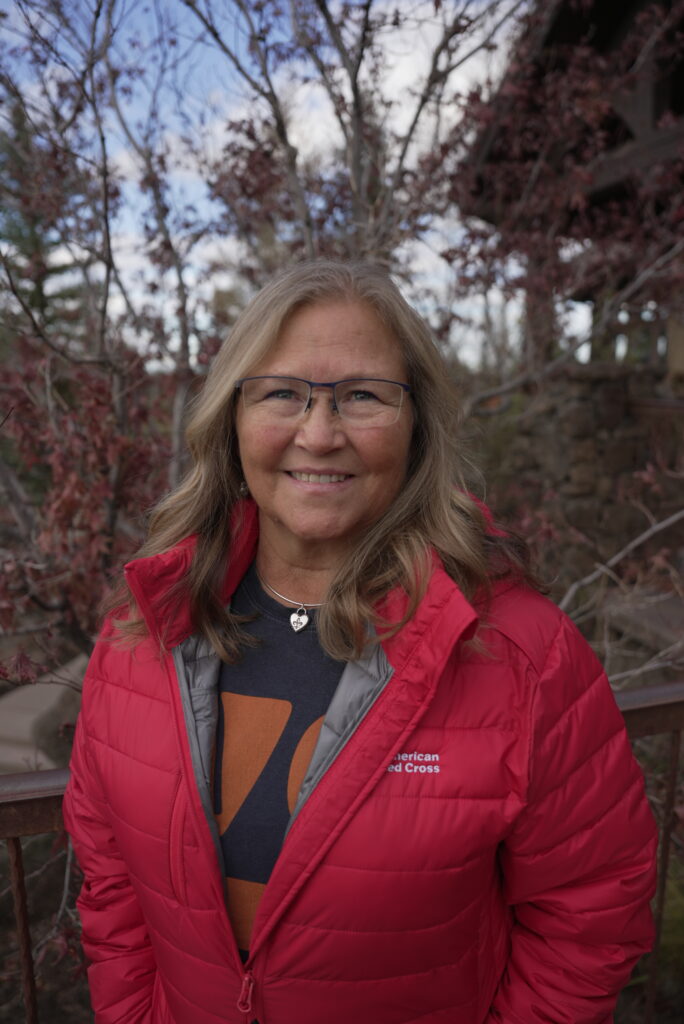It Took 250 Gallons of Blood to Save Her Life, Now She’s a Cardiac Nurse
Patricia Griffiths, Red Cross Cascades Region

Not even the tap of a fork hitting a plate was heard during the 500-person 2013 Red Cross Cascades Region Heroes banquet while Sandy Schill told the story of how her life was saved.
Her story started in 1986 with a seemingly innocuous on-the-job headache while working in retail shoe sales. Over the next few days, her condition plummeted from flu-like symptoms to being incoherent and unable to communicate, resulting in her being hospitalized. At that point, the 22-year-old relaxed, feeling confident that she would be alright soon.
But, she was wrong. Sandy had a rare blood condition that required extraordinary efforts by hundreds of people for years to keep her alive.
“I had to have apheresis every day until I stopped killing my blood cells,” she said, “because I was killing my blood cells almost as fast as they could put them in me.” (Apheresis is the process of filtering blood to remove one component, then returning the rest to the patient.) As for her hope for a quick recovery, she said, “over the course of two years, the blood disease would just show itself, then go away,” then recur again and again in a frustrating cycle.
Treating and comforting her were Red Cross nurses that she befriended. “We watched ‘The Young and the Restless’ three days a week!” That time with the Red Cross team turned her thoughts to where the blood she depended on came from.
“I’m taking a lot. There must be a lot of people out there giving it just for me, right?” The nurses then explained how the Red Cross blood drives work.
“But, I joked, what do they get for donating? They said, ‘oh they donate so many times, they get a tote bag.’” Sandy responded, “Is that it? How about after 1,000 times? They get a mug! That was back in the ‘80s and I thought that was so funny, they get a mug!”
The nurses remembered that, and, when Sandy crossed the threshold of having received 1,000 units of blood, they presented her with a Red Cross mug. “I still have that mug today! It is the most sentimental item I own!”
Her life continued to depend on receiving blood, and she passed the threshold of 2,000 units, or pints, of blood. That amounts to more than 250 gallons of blood!
At the 2013 Heroes Breakfast, that quantity was depicted in a massive pyramid of 5-gallon Home Depot buckets. She gestured to the 500-person audience, and said, “all of you had to have donated at least three times for me to be alive.”
Thanks to those donations, today Sandy is an energetic cardiac nurse, who pulls lessons learned while a patient to her profession. “Every patient gets three units of blood that’s a cross match for them. I look at that those units of blood and they are so important to me!” She added, “If I see someone mismanaging or holding it, I say, don’t! that’s a unit of blood! You have to be nice to that!”
For Sandy, not only is each unit of blood precious, but she has observed that the need for blood has grown due to changes in technology and laws. Hospitals “are becoming better at saving people that require massive blood transfusions [as a result of] improvements in the machinery and training,” she said. She also noted that the state motorcycle helmet laws have resulted in 30% more crash victims making it to the hospital, requiring 20-30 units of blood to survive. The takeaway is saving more people means more blood donations are needed.
Sandy has taken this charge personally. By telling people her story, she highlights the importance of blood donations. For this cardiac nurse and rare blood disease survivor, this epiphany has focused her, as she said, “I think now this is my next direction of how to return service.”
If you would like to help people like Sandy survive illness or traumatic injuries, consider donating blood. It’s a chance to make a difference in the world by saving one person at a time. Go to www.redcross.org/donate.